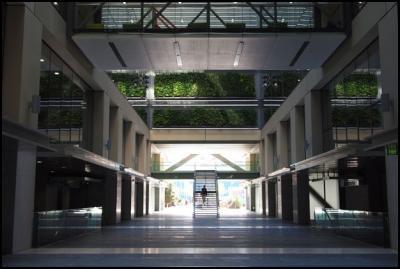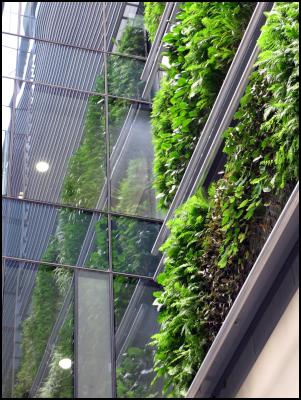New Zealand’s Largest Living Wall Makes a Bold Statement

Click for big version
New Zealand’s Largest Living Wall Makes a Bold Statement
Auckland’s Britomart precinct with its chic bars and trendy restaurants is the place to be seen. But the real must see of this up and coming area are the three-storey high vertical gardens by Natural Habitats. These eco-artworks are the focal point of the atrium at the new Britomart East building, which has a New Zealand Green Building Council five-star rating.
The living walls are the largest in New Zealand. They live on harvested rainwater and provide many environmental benefits to the complex, which is one of the most environmentally friendly buildings in New Zealand. Indoor green walls are one of the best ways to achieve maximum plant coverage in minimum space to improve air quality. Studies show that indoor plants improve air quality through the removal of VOC’s (volatile organic compounds) and through the regulation of temperature and humidity levels.
To achieve this the walls’ have a custom designed planting palette that features a combination of native and exotic epiphytes, ferns, climbers and groundcovers, chosen for their low light and maintenance requirements. A collection of flowering plants provide seasonal variety, and have been specially chosen to ensure falling drifts of petals don’t stain the steel grey tiles below. The overall composition was influenced by the shadows that fall on the wall during the day, with repetition of planting patterns loosely referencing those found in traditional Maori carvings.

Click for big version
As the walls are only 120mm deep, containing an inert medium as opposed to soil they can be easily fixed into the atrium’s existing stud pattern. They are an ideal light weight solution to the question of how to differentiate the complex’s interior aesthetic. Other design features include a customised flat tray guttering system which complements the clean lines of the architecture, a remotely monitored irrigation system and light sensors which ensure additional lighting comes on when light levels fall below minimum requirements.
Sitting between two to five stories above ground level the walls’ 60 custom made panels had to be carefully installed using a building maintenance unit and abseiling equipment, which was undertaken by Natural Habitats over a two week period in February.
Natural Habitats is also responsible for ongoing maintenance; and can be found up the wall every fortnight making sure the plants adjust to their new surroundings. “The walls’ are essentially a hydroponic system which is fully irrigated and fertigated” says Natural Habitats’ site manager Brent Atherfold.
The vegetation is expected to reach full coverage in the next month or so, and provided these vertical gardens are properly maintained they will last indefinitely. The wall is being well received by the complex’s occupants “the green wall has been the single most outstanding feature of our new work environment. It causes people to stop and take time out to look at the detail of it, which is extremely important in an otherwise rushed corporate environment” notes one worker. While trends change and fashions fade, these vertical gardens will continue to set to the scene and the pace for the future growth of the Britomart precinct.
ENDS
Natural Habitats living walls are situated in the atrium of the Britomart East complex, which houses both the Ernst & Young and Westpac HQ. The public thoroughfare also provides access to Britomart’s underground train platform.
For more information on green walls visit www.greenwalls.co.nz


 BusinessNZ Energy Council: Forging International Partnerships In Energy
BusinessNZ Energy Council: Forging International Partnerships In Energy Hugh Grant: Empowering Financial Insights With A News API
Hugh Grant: Empowering Financial Insights With A News API Nathan Cooper, The Conversation: Unambitious And Undermined - Why NZ’s Latest Climate Pledge Lacks The Crucial ‘Good Faith’ Factor
Nathan Cooper, The Conversation: Unambitious And Undermined - Why NZ’s Latest Climate Pledge Lacks The Crucial ‘Good Faith’ Factor KiwiRail: Remutaka Tunnel Renewal Complete, Trains Back In Service Monday Morning
KiwiRail: Remutaka Tunnel Renewal Complete, Trains Back In Service Monday Morning Cawthron Institute: Independent Science Could Break Stalemates In Global Plastics Treaty Negotiations
Cawthron Institute: Independent Science Could Break Stalemates In Global Plastics Treaty Negotiations KiwiRail: Great Journeys New Zealand Brings The ‘WOW’ Factor With VIP Packages
KiwiRail: Great Journeys New Zealand Brings The ‘WOW’ Factor With VIP Packages



